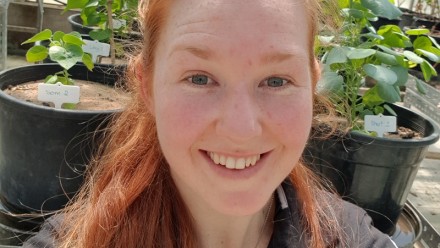PS Webinar Series: PhD Exit Webinar - Future-proofing cotton production by building resilient photosynthetic pathways
Abstract - In order to sustain and improve cotton (Gossypium hirsutum) production in future climates with increasingly hot mean annual temperatures and more frequent and extreme heatwaves, developing climate-adapted cotton cultivars is required. Enhancing crop photosynthetic performance and thermal resilience may be achieved through improving the catalytic properties of the key photosynthetic enzyme, Rubisco. This research aims to elucidate the potential to utilise photosynthetic traits from within the Gossypium genus in the development of climate-adapted germplasm. The central focus of this investigation is to interrogate the extent of diversity in photosynthetic performance and resilience between diverse species of Gossypium, and the cultivated Gossypium hirsutum. The secondary aim of this study is to elucidate the temperature dependency of cotton photosynthesis and build an understanding of the physiological and biochemical mechanisms behind photosynthetic thermotolerance in diverse Gossypium species. This will provide novel information for simulating the effects of such mechanisms on crop growth processes to determine the level of photosynthetic enhancement required to improve crop yield and heat stress resilience. Analyses of photosynthetic gas-exchange measurements and a range of biochemical assays to determine Rubisco catalytic properties under various temperature treatments forms the basis of this research.
Biography - My parents emigrated from Northern Ireland, settling in country Victoria, where I grew up with three other siblings on our family-run dairy farm. I attended Katunga Primary School, followed by Numurkah Secondary School (I’m amazed if people happen to know either of those towns). I obtained a Bachelor of Science from the University of Melbourne, and continued there to do a Master of Science with Dr. Jason Goodger and Prof. Ian Woodrow. I studied the ecophysiology of volatile secondary metabolites produced in vegetative and reproductive tissues in the Blue Mallee, Eucalyptus polybractea. However, at the conclusion of my Bachelor and prior to starting my Masters, I was fortunate enough to be accepted into the CSIRO Summer Research Scholarship program. I worked on a project investigating heat and drought stress physiology of cotton, supervised by Dr. Nicola Cottee and Dr. Warren Conaty from the CSIRO in Narrabri. During my Masters, Warren invited me to the Australian Cotton Research Conference to present our findings from my summer project, and it was at this event that I approached Warren about doing a PhD in cotton. It was about as stressful as a proposal – but he said yes! We agreed to seek out a university supervisor from ANU, as Warren had some connections there. My partner, Brad, and I drove to Canberra, where I met Rob Sharwood. I remember thinking that I’ve never met a human more enthusiastic about anything in my life! Thankfully, Rob was also eager to take me on as a PhD student in collaboration with Warren. My PhD officially started on February 27, 2017. I’ve been based at Narrabri, travelling to Canberra for my experiments, much to the confusion of other RSB students – some referred to me as the phantom PhD student!





